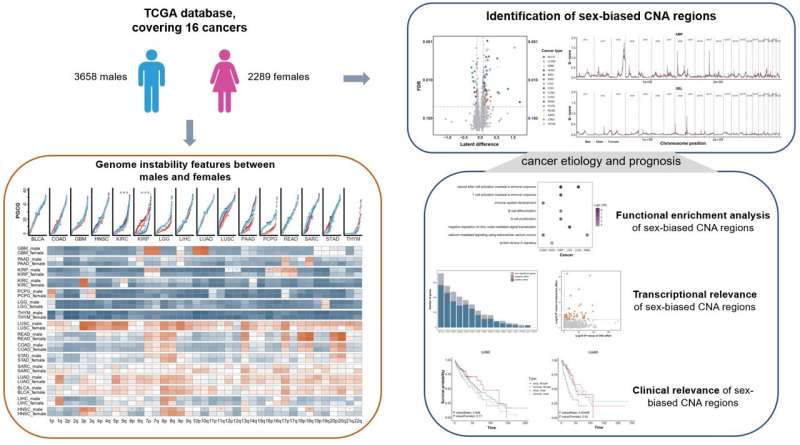Scientists from Peking University Health Science Center investigated sex differences in genome instability across 16 cancer types, identifying male-biased and female-biased copy number alterations (CNAs) with significant impacts on gene transcription and potential as sex-specific prognostic biomarkers. Credit: Chunmei Cui, School of Basic Medical Sciences Peking University
Recent research spearheaded by Chunmei Cui at the State Key Laboratory of Vascular Homeostasis and Remodeling, Peking University, China, casts a new light on the nuanced interplay between gender and cancer, uncovering significant sex-specific disparities in copy number alterations (CNA) across various cancer types.
Published in Health Data Science, this study delineates the intricate ways in which these alterations influence cancer biology, offering a beacon for future therapeutic strategies.
"At the crux of cancer research, understanding the divergent paths this disease takes in men and women is paramount," explains Chunmei Cui. "Our latest findings delve into the heart of this divergence, revealing distinct genomic imbalances that underscore the importance of a gender-tailored approach in cancer prognosis and treatment."
The study unveils pronounced differences in genomic instability, particularly in cancers of the kidney, lung, liver, and head and neck, spotlighting the profound impact of sex-biased CNAs on gene expression and their potential as prognostic biomarkers. Remarkably, over 60% of genes within these CNA regions are significantly swayed by these alterations, with approximately 14% of their mRNA abundance being influenced by both gender and CNA.
"Our insights into these gender-specific genetic alterations pave the way for more personalized cancer care, highlighting the necessity of integrating gender considerations into prognostic models and therapeutic interventions," Cui emphasizes.
Further validating its methodology, the study corroborates the robustness of the CNGPLD tool over traditional statistical approaches, enhancing the accuracy of detecting sex-specific genetic differences. Notably, the research expands its implications beyond the widely acknowledged sex disparities in lung and kidney cancers, identifying critical sex-biased CNA regions in head and neck cancer and lower-grade glioma.
Looking ahead, Cui envisions a future where these findings catalyze the development of gender-specific biomarkers and therapeutic avenues, reinforcing the commitment to personalized medicine. "The next phase of our research will focus on validating these CNAs in independent cohorts and elucidating their roles in cancer mechanisms, with the ultimate goal of translating these discoveries into clinical practice," she concludes.
More information: Chenhao Zhang et al, Identification and Analysis of Sex-Biased Copy Number Alterations, Health Data Science (2024). DOI: 10.34133/hds.0121
Provided by Health Data Science
























